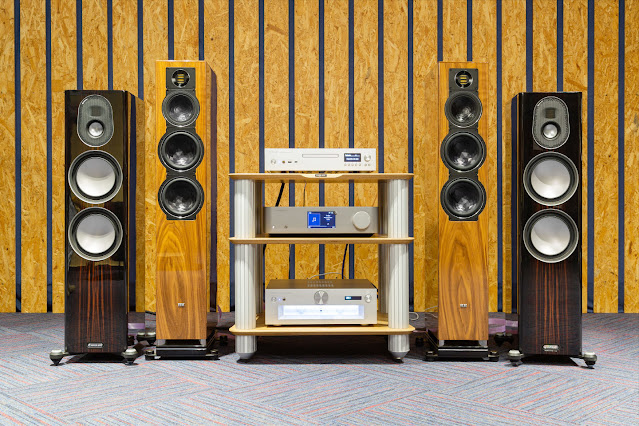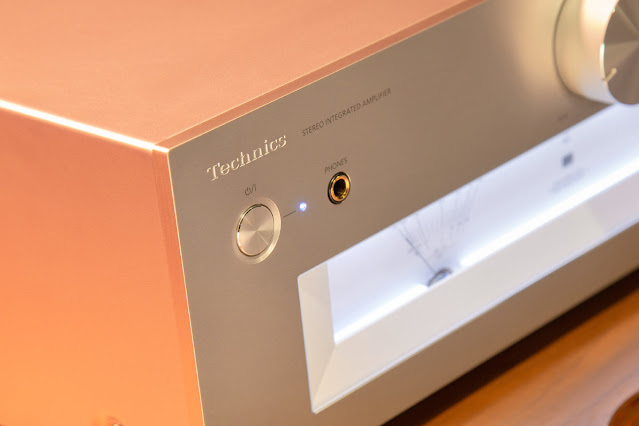Technics SU-G700 Amplifier Review
Recognizable classic look and richly detailed sound, together with non-standard and unusual technical solutions for brand fans - this is the concept of this amplifier. The Japanese company considered that the result is more important than the process, and at the audition, we were convinced of this ourselves.
If you are nostalgic for those very Technics amplifiers with arrows, then the appearance of the new SU-G700 model, which carries a certain collective image of the line of yesteryear, I think you will like it. Strict rectangular lines of the case and a large plastic window with two VU indicators refer us to the 900th and 1000th series, and the large round volume knob in the center at the top reminds of branded integrated circuits.
But the inner content, perhaps, will cause cognitive dissonance and pain (think where yourself) in orthodox audiophiles. Before us is an integrated amplifier with a class D pulse circuit and several stages of digital signal conversion. Judge for yourself - already at the very beginning, the analog signal is converted to digital 192 kHz / 24 bits using the built-in Burr-Brown PCM1804 ADC from Texas Instruments.
 |
Amplifier design reveals a modern take on classics from the recent past |
And this happens not only on a pair of analog RCA line inputs but also on the input of an MM phono stage - just imagine the feelings of vinyl adherents! So forget about the company's former pride - the MOS class AA circuit (which, by the way, has nothing to do with the operating mode of the amplifier, but means an assembly of two amplifiers: on MOSFETs and bipolar transistors). Of course, special attention was paid here to class-like digital inputs: a pair of optical and coaxial, as well as USB-B for connecting to a computer.
The control above all else
This solution, which is not the most common for this price category (and it is also used in the SE-R1 reference series, which is not yet available in all countries), is dictated by the company's new approach, which can be loosely expressed by the well-known expression “do you want to check or go?”.
In other words, Technics is committed to providing you with accurate, detailed and musical sound with confident control over a wide variety of acoustics - and the methods they choose.
 |
To protect against internal interference in the amplifier, a three-node layout was used. |
To begin with, in order to eliminate the almost inevitable jitter and accompanying noise during digital signal processing, the company used proprietary JENO Engine (Jitter Elimination and Noise-shaping Optimization) technology. In particular, a special battery-powered clock generator and a precision PWM module are involved here.
The main control is assigned to the LAPC (Load Adaptive Phase Calibration) technology, which corrects the phase characteristics in real-time, continuously matching them to the constantly changing and frequency-dependent speaker impedance. As a result, engineers were able to obtain a smooth, powerful signal over the entire frequency range.
 |
Internal baffles add rigidity to an already rugged chassis |
The Japanese paid special attention to protection against parasitic noise and radiation. First of all, the amplifier case was divided into three almost equal parts, placing various circuits and a switching hybrid power supply in them. Also, internal baffles gave additional rigidity and vibration resistance to the already strong aluminum case on a double frame and with a steel bottom plate.
More noise-reducing circuitry and components have been added to the power system, computer input amplifier, clock power, and Phono input.
However, Technics did not completely forget about a variation on the theme of its own AA amplification circuit (and again not to be confused with the operating mode) - it is used in the headphone output. Here, a high PWM signal, converted to analog, is fed to a separate two-loop amplifier.
Accompanies any performer
In order to better understand the capabilities of the amplifier and distinguish between its own presentation and the nature of the acoustics, we prepared two pairs of equivalent speakers at once. Close to the top floor models ELAC FS 409 and Monitor Audio Gold 300 5G at the time of testing for the promotion cost the same to within a ruble. Both have similar sensitivity characteristics (89 and 90 dB), the same impedance of 4 ohms, and a similar speaker layout - a ribbon tweeter, a midrange radiator, and a pair of woofers.
 |
Dissimilar in appearance and in nature, the columns demonstrated a flow similar in detail and volume |
To begin with, let's test the analog connection and help us with this ... Cambridge Audio Edge NQ digital network player, which has earned us high praise precisely for its high-quality natural sound transformation. Moreover, it has only analog outputs, and we will now use the unbalanced Pre-Out.
To connect the player to the network, speakers and amplifier, we did not use assorted cables, but used the medium-budget and at the same time fairly high-quality Nordost Explorer kit, which just for this case offers a ready-made solution out of the box.
 |
The variety of inputs allows you to work with analog and digital devices, but further signal processing is always digital |
First, let's offer the audio system a baroque classic in the form of the JS Bach album that I often use. Oboenwerke. Alexey Utkin. Hermitage Chamber Orchestra. Speakers from ELAC immediately built a lively and very voluminous, almost three-dimensional picture. I compared these works on different setups, and here I noticed a very good balance and distinctness of all instruments at the same time as an informatively built scene.
But still, I’ll find fault with it a little - the main character, that is, the oboe, seemed to me too light and not bodily enough. I change the speakers to Monitor Audio - and the sound became a little softer, and velvety, but most importantly, the oboe seemed to have found its wooden case and, along with it, warmth and naturalness.
But the general supply is practically preserved. All the same scene, the same volume and arrangement of instruments, along with excellent balance. Both pairs of speakers displayed other classical genres in the same informative and voluminous way, whether it was Verdi's large-scale "Chorus of the Hebrew Slaves from Nabucco" from the Slovak Philarmonic Chorus and Radio Symphony Orchestra or the overture to "Le nozze di Figaro ossia la folle giornata" by Mozart from another Slovak orchestra Capella Istropolitana.
 |
The device has a separate amplifier of the proprietary AA circuit for headphones with dedicated voltage and current amplification circuits |
In both cases, the amplifier provides excellent reproduction of the nuances of the soundtrack over the entire wide orchestral range. The only difference is that ELAC play German correctly and scrupulously, and Monitor Audio seems to soften this straightforwardness and seem a little more analog.
Let's go back to the present. The composition "Uprising" by Muse is not only replete with deliberately overloaded and distorted sounds, but it is recorded a little unclear. But the amplifier did not seem to notice this and, with both pairs of speakers, presented the song not just in volume, but downright holographic - with soaring vocals and distinct vibrating bottoms. Once again, the ELACs were brighter and more aggressive, while the Monitors were a bit softer and more comfortable.
And this is where my hunting instinct woke up, and I started throwing compositions to the amplifier, with which some setups had problems. Massive "Radio" Rammstein with its overloaded bottoms Technics as if dismantled into details and filed clearly and distinctly. What is strange - this time the song sounded harder and more aggressive in the interpretation of Monitor Audio.
In the instrumental composition "Satin Shores" by Valery Didula and Dmitry Malikov, the piano almost always seemed unnaturally glassy, but now it has acquired the long-awaited naturalness. A somewhat smeared Def Leppard song “Rock! Rock! (Till You Drop)” was unexpectedly bright and distinct this time.
On the contrary, I chose the electronic piece "The Race" by Yello for its good quality and abundance of stereo effects. And now both pairs of speakers seem to have turned it into a surround sound show. I also managed to hear a few previously unnoticed nuances and stereo effects on the remastered CD “Blood Type” by Maschina Records.
First-person
If now we were listening to digital recordings with the deliciously prepared analog conversion from Cambridge Audio Edge NQ, which the amplifier then re-digitized, now let's compare this feed with our own processing from the Technics SU-G700 itself. And the source here will be a native CD/network player Technics Super Audio CD SL-G700, connected via a coaxial interface.
 |
The large volume knob is so pleasant to the touch that you want to put the remote control aside and get up from your chair once again. |
I sort through the same musical material - and everywhere a similar volumetric balanced presentation is preserved, but the sound has become a little lighter, colder and more transparent. Whether it's a plus or a minus is a matter of personal taste. But when choosing an amplifier, you need to keep two things in mind: it is able to reliably reveal the features of an analog source, and, at the same time, it has its own character when processing an external digital signal.
In general, I got the impression that the Technics SU-G700 is able to handle any soundtrack and pull everything out of the recording, regardless of genre. And every time it will be a high-quality, voluminous and effective presentation. By the way, during the entire listening, the volume level was about 30-40% of the maximum.
Think a lot of flattering words? Well, here's the cherry on the cake for you - yes, the sound of the amplifier is emphatically correct, but to such an extent that you already want some individual nuances. This apparatus reminds me of the Asian virtuosos who flooded the prestigious classical music competitions.
Although they have an impeccably correct technique, honed by countless persistent repetitions, they resemble ideal and therefore similar musical robots. So the Technics SU-G700 seems to offer a mathematical model of the perfect sound in his understanding when sometimes you want something from the heart.
Conclusion
This amplifier will appeal to very demanding music lovers who need equally confident and accurate presentation of a wide variety of musical genres. And if you dream up - it is also perfect for music lessons, small clubs and music lectures. Without a doubt, he will clearly reveal and show all the features of the classics, folk art, modern rhythms - and further down the list.
But tremulous fans of certain musical trends, as well as staunch audiophiles, may need something more lively and individual. Although, most likely, you will have to look in a higher price category.
PROS
Confident work with almost any musical material on different acoustics. Clear legible presentation of difficult-to-play recordings. Emphasized surround sound. Attractive classic design.
CONS
Own digital processing could be warmer and more natural.
OFFICIAL SITE
Technics SU-G700
Specifications Technics SU-G700
Number of channels: 2
Output Power: 2 x 70W (1kHz, 0.5% NCL, 8Ω, 20kHz LPF); 2 x 140W (1kHz, 0.5% NCL, 4Ω, 20kHz LPF)
Inputs: Phono MM, 2 x optical, 2 x coaxial, USB-B (PC), 2 x analog line
Outputs: analog linear and Pre-Out; headphones 6.3 mm, 0.75 mW, 32 ohm
Supported formats: PCM up to 32bit/384kHz, DSD 11.2MHz
Power Consumption: 85W
Frequency response Line input 5 Hz - 80 kHz (-3 dB, 8 ohms), Phono input 20 Hz - 20 kHz (RIAA deviation ±1 dB, 8 ohms), Digital input 5 Hz - 90 kHz (-3 dB, 8 ohm)
Dimensions (WxHxD): 430 x 148 x 428 mm
Weight: 12.3 kg
















.jpg)



0 Comments